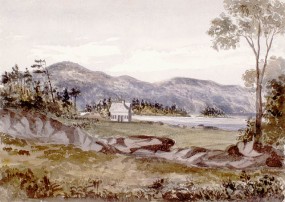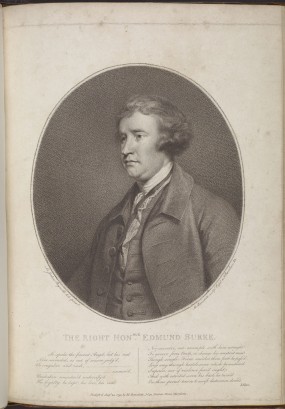Emigration and Settlement
- How does Moodie characterize the
dealers in wild lands
in her Introduction? - Consider how Moodie describes the motivations to emigrate and her experiences and feelings about the process in the Introduction. What is the mood of this section, and how does she address common misconceptions of emigration and the newly adopted land? How does this introduction situate the accompanying autobiography and reflection?
- What is the tone of the later chapters as she settles into the Lakes district? Is she more comfortable with the setting, the work, and the challenges of the situation? What does she value and what does she despise about her situation?
Settler Relations

Grosse Isle. Henry High Manvers Percy (ca. 1838-1840). Library and Archives Canada, acc. no. 1939-322-22, c013624k
- Consider Moodie’s descriptions, such as in the chapter on Grosse Isle, of different groups of people, including the English as high-souled, the Irish as sun-burnt harpies, and Indigenous peoples as Nature’s gentlemen. How does this position her as an English woman in relation to the other groups of people? How does she indicate her variable perceptions of different people? How do these values shift throughout the text?
- Examine Moodie’s encounters with Emily,
Old Satan,
Mrs. Fye, and Betty inOur First Settlement, and the Borrowing System.
What does she learn about her new neighbours’ way of life? How does she handle their requests? What does this suggest about her position in the community as a new British emigrant?
Colonial Bias
- Consider Moodie’s descriptions of other classes, ethnicities, and races. How might her observations reflect her British heritage and colonial assumptions? How might she be appealing to shared knowledge with her audience to make her foreign experiences more accessible and intelligible? Does she attempt to alter the perceptions and assumptions of her audience in order to illustrate their differences with emerging Canadian society?
- Consider how the various social values Moodie describes reflect her particular biases as a genteel British emigrant. Consider especially her descriptions of other ethnic and racial groups. See the
Moodie’s Subjective Eye
search term analysis exercise for one approach to unpacking these considerations.
Rhetorical Strategies
- Consider the strategies Moodie uses to make her text appear as factual as possible, such as the style of description and the use of dialects. How might we reconcile these strategies with the contrasting moments of melodramatic or figurative language?
Gender and Perspective
- How does Moodie’s gender impact her engagement with people, compared with the social mobility of her husband? How does her role as a home-maker in the domestic sphere limit her exposure to social interactions? How does the experience of travel impact these private/public divisions? How does her experience of homesteading, the diversity of neighbors, and approaches to social expectations subtly alter her perspective?
- Examine Moodie’s interactions with
Brian, the Still-Hunter
and her assessments of his invasion of her private sphere. How does her assessment of Brian change over the course of the chapter? What events and comments instigate these changes? Is Brian a parallel figure to Moodie—another figure whose mental state is under pressure from his engagement with society and the landscape?
Landscapes

Edmund Burke. “The Right Honble. Edmund Burke.” 24 Aug. 1791. Library and Archives Canada, e010940124-v8
Moodie often describes the landscape and nature as overwhelming, particularly in the chapter on Grosse Isle. Her writing is influenced by philosopher Edmund Burke’s notion of the sublime, which is an expression of both awe and anxiety over the greatness or vastness of a scene. It reflects something that we are attracted to yet cannot comprehend or envision in its totality, or that makes us sense our own mortality. Consider moments in which Moodie reflects this type of experience of Canada.
- How do Moodie’s descriptions of water, specifically in the chapter on Grosse Isle, contrast with her depictions of the still woods? How do these opposing landscapes inform her assessment of her fellow European settlers?
- In her article
Cartographic Lessons: Susanna Moodie’s Roughing It in the Bush and Thomas King’s Green Grass, Running Water
, Florence Stratton argues that Moodie engages in a colonial project of erasure and re-naming. Stratton shows how maps areinstruments of knowledge and power
(83), and how expressions ofcolonial violence
are evident through the erasure of Indigenous place names (84). Stratton argues that the colonial process of re-naming normalizedthe death and suffering of First Nations people
and promoted the myth of thevanishing Indian
(86) and theempty continent
(87). Do you agree with Stratton’s argument? Why or why not? Support your opinion with further evidence from the text.
Works Cited
- Burke, Edmund, and James T. Boulton. A Philosophical Enquiry into the Origin of our Ideas of the Sublime and Beautiful. Oxford: Basil Blackwell, 1987. Print.
- Moodie, Susanna. Roughing It in the Bush, Or, Life in Canada. Toronto: Penguin Canada, 2006. Print.
- Stratton, Florence.
Cartographic Lessons: Susanna Moodie’s Roughing It in the Bush and Thomas King’s Green Grass, Running Water.
Canadian Literature 161–62 (1999): 82–102. Print. (PDF)








 ©
©